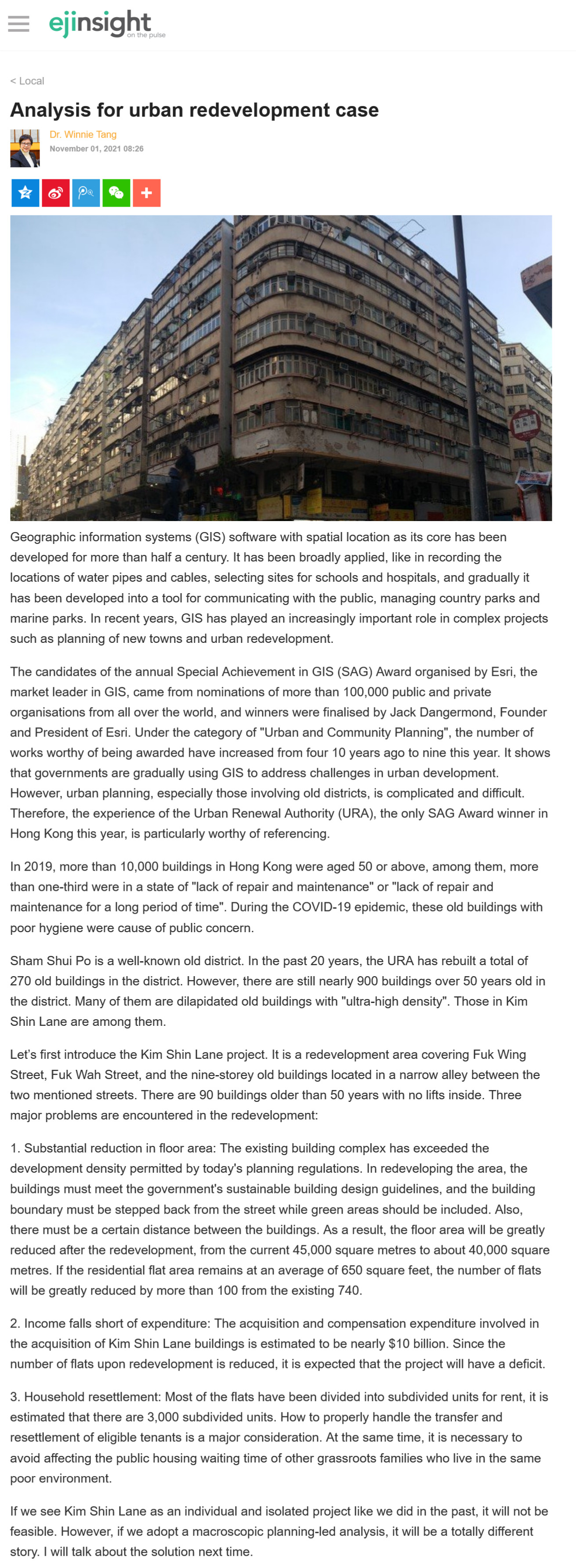網上版請按此

Analysis for urban redevelopment case
Geographic information systems (GIS) software with spatial location as its core has been developed for more than half a century. It has been broadly applied, like in recording the locations of water pipes and cables, selecting sites for schools and hospitals, and gradually it has been developed into a tool for communicating with the public, managing country parks and marine parks. In recent years, GIS has played an increasingly important role in complex projects such as planning of new towns and urban redevelopment.
The candidates of the annual Special Achievement in GIS (SAG) Award organised by Esri, the market leader in GIS, came from nominations of more than 100,000 public and private organisations from all over the world, and winners were finalised by Jack Dangermond, Founder and President of Esri. Under the category of "Urban and Community Planning", the number of works worthy of being awarded have increased from four 10 years ago to nine this year. It shows that governments are gradually using GIS to address challenges in urban development. However, urban planning, especially those involving old districts, is complicated and difficult. Therefore, the experience of the Urban Renewal Authority (URA), the only SAG Award winner in Hong Kong this year, is particularly worthy of referencing.
In 2019, more than 10,000 buildings in Hong Kong were aged 50 or above, among them, more than one-third were in a state of "lack of repair and maintenance" or "lack of repair and maintenance for a long period of time". During the COVID-19 epidemic, these old buildings with poor hygiene were cause of public concern.
Sham Shui Po is a well-known old district. In the past 20 years, the URA has rebuilt a total of 270 old buildings in the district. However, there are still nearly 900 buildings over 50 years old in the district. Many of them are dilapidated old buildings with "ultra-high density". Those in Kim Shin Lane are among them.
Let's first introduce the Kim Shin Lane project. It is a redevelopment area covering Fuk Wing Street, Fuk Wah Street, and the nine-storey old buildings located in a narrow alley between the two mentioned streets. There are 90 buildings older than 50 years with no lifts inside. Three major problems are encountered in the redevelopment:
1. Substantial reduction in floor area: The existing building complex has exceeded the development density permitted by today's planning regulations. In redeveloping the area, the buildings must meet the government's sustainable building design guidelines, and the building boundary must be stepped back from the street while green areas should be included. Also, there must be a certain distance between the buildings. As a result, the floor area will be greatly reduced after the redevelopment, from the current 45,000 square metres to about 40,000 square metres. If the residential flat area remains at an average of 650 square feet, the number of flats will be greatly reduced by more than 100 from the existing 740.
2. Income falls short of expenditure: The acquisition and compensation expenditure involved in the acquisition of Kim Shin Lane buildings is estimated to be nearly $10 billion. Since the number of flats upon redevelopment is reduced, it is expected that the project will have a deficit.
3. Household resettlement: Most of the flats have been divided into subdivided units for rent, it is estimated that there are 3,000 subdivided units. How to properly handle the transfer and resettlement of eligible tenants is a major consideration. At the same time, it is necessary to avoid affecting the public housing waiting time of other grassroots families who live in the same poor environment.
If we see Kim Shin Lane as an individual and isolated project like we did in the past, it will not be feasible. However, if we adopt a macroscopic planning-led analysis, it will be a totally different story. I will talk about the solution next time.
Dr. Winnie Tang
Adjunct Professor, Department of Computer Science, Faculty of Engineering; Department of Geography, Faculty of Social Sciences; and Faculty of Architecture, The University of Hong Kong